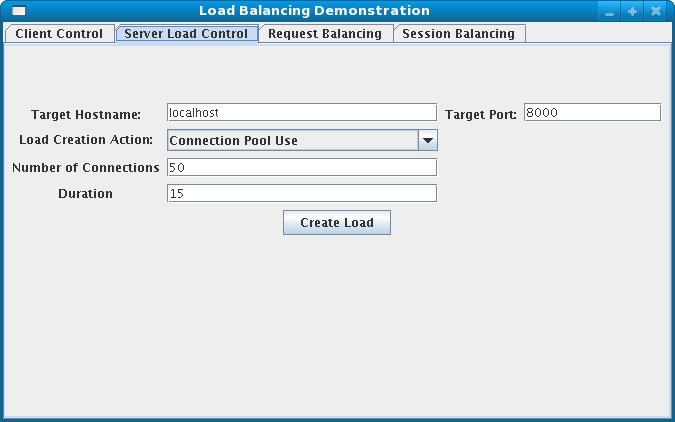Dieser Inhalt ist in der von Ihnen ausgewählten Sprache nicht verfügbar.
Chapter 12. Load balancing demonstration
JBOSS_EAP_DIST/mod_cluster/demo directory.
/server/load-demo.war- A WAR file to be deployed in JBoss Enterprise Application Platform or JBoss Enterprise Web Server. This WAR includes a number of servlets.
/client/lib/mod-cluster-demo.jar- A web application that lets users launch a pool of threads, by sending requests through the load balancer to the application's primary servlet. The application displays information about which servers are handling the requests. It can also send separate requests to the application's load-generation servlets, allowing the user to see how certain load conditions affect request load balancing.
Important
Note
12.1. Set up the demonstration
Task: Start the Demo
Prerequisites
- Install and Configure the Worker Node. Refer to Section 8.2, “Install and configure a worker node”
- Install and Configure the Proxy Server. Refer to Section 9.1, “Static proxy configuration”
Start the Proxy Server
Navigate toHTTPD_DIST/sbinand start the proxy server.apachectl start
[sbin]$ apachectl startCopy to Clipboard Copied! Toggle word wrap Toggle overflow Start the Worker Node
In a terminal, execute the following command:- For JBoss Enterprise Web Server:
./JBOSS_EWS_DIST/tomcat6/bin/startup.sh
[home]$ ./JBOSS_EWS_DIST/tomcat6/bin/startup.shCopy to Clipboard Copied! Toggle word wrap Toggle overflow - For JBoss Enterprise Application Platform:
./JBOSS_EAP_DIST/bin/run.sh
[home]$ ./JBOSS_EAP_DIST/bin/run.shCopy to Clipboard Copied! Toggle word wrap Toggle overflow
On JBoss Enterprise Web Server, specify the Catalina Service Name
Tomcat 6 only: In$JBOSS_EWS_DIST/mod_cluster/src/demo/resources/web.xml, under the<web-app>element, append a<context-param>directive, which specifies Catalina as a service.<context-param> <param-name>service-name</param-name> <param-value>Catalina</param-value> </context-param>
<context-param> <param-name>service-name</param-name> <param-value>Catalina</param-value> </context-param>Copy to Clipboard Copied! Toggle word wrap Toggle overflow Deploy Demo Web Archive to Worker Node
Copyload-demo.warfromJBOSS-EAP_DIST/mod_cluster/demo/serverinto one of the following directories:- For JBoss Enterprise Web Server:
JBOSS_EWS_DIST/tomcat6/webapps - For JBoss Enterprise Application Platform:
JBOSS_EAP_DIST/jboss-as/server/PROFILE/deploy
Start the Demonstration
Navigate toJBOSS_EAP_DIST/mod_cluster/demo/client/, and start the demonstration../run-demo.sh
[client]$ ./run-demo.shCopy to Clipboard Copied! Toggle word wrap Toggle overflow ResultThe demonstration starts, and the Load Balancing Demonstration window opens. Proceed to Task: Configure Client Control Tab Fields
